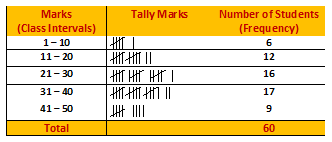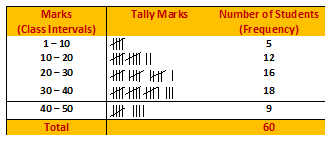CLASS-9
FREQUENCY OF DISTRIBUTION - GROUPED DATA
Grouped Date –
To put the data in a more condensed or intact form, we need to make groups of suitable size, and should mention the frequency of each and every group. That kind of table is to be considered or called as a grouped frequency distribution table.
Class Interval – If into each group where the raw data is condensed or accumulated or collected intactly, is called or considered as a class-interval. Each class would be bounded by two figures, which are called or considered as class limits. The figure on the left side of a class is called or considered of its lower limit and that on its right is called its upper limit.
Types of Grouped Frequency Distribution –
1) Exclusive Form (or Continuous Interval Form) : A frequency distribution in which or where the upper limit of each class will be excluded and lower limit will be included, and this will be called an exclusive form.
Example : Suppose the marks obtained by some students in an examination are given. We may consider the classes 0 – 10, 10 – 20, etc. In class 0 – 10, we include 0 and exclude 10. In class 10 – 20, we include 10 and exclude 20.
2) Inclusive Form (or Discontinuous Interval Form) : A frequency distribution in which each upper limit as well as lower limit is included, is called an inclusive form. Thus, we have classes of the form 0 – 10, 11 – 20, 21 – 30, etc. In 0 – 10, both 0 & 10 are included.
Example.1) Given below are the marks obtained by 60 students in an examination: -
3, 25, 48, 23, 17, 13, 11, 9, 46, 41, 37, 45, 10, 19, 39, 36, 34, 5, 17, 21, 39, 33, 28, 25, 12, 3, 8, 17, 48, 34, 15, 19, 32, 32, 19, 21, 28, 32, 20, 23, 25, 27, 32, 37, 19, 32, 26, 29, 24, 30, 37, 23, 32, 43, 47, 29, 49, 31, 45, 37.
Arrange the data in ascending order and present it as a grouped data in ;
a) Discontinuous interval form, taking class intervals 1 – 10, 11 – 20, etc.
b) Continuous Interval form, taking class intervals 1 – 10, 10 – 20, etc.
Solution:- Arranging the above given numbers or marks in ascending order, and we get –
3, 3, 5, 8, 9, 10, 11, 12, 13, 15, 17, 17, 17, 19, 19, 19, 19, 20, 21, 21, 23, 23, 23, 24, 25, 25, 25, 26, 27, 28, 28, 29, 29, 30, 31, 32, 32, 32, 32, 32, 32, 33, 34, 34, 36, 37, 37, 37, 37, 39, 39, 43, 47, 41, 45, 45, 46, 48, 48, 49
Now we may classify them into groups as shown below –
a) Discontinuous Interval Form (or Inclusive Form) –
Note that – the class 1 – 10 means, marks obtained from 1 to 10, including both. Same is applicable for other group also.

b) Continuous Interval Form (or Exclusive Form)
Note that – the class 1 – 10 means, marks obtained from 1 to 9, excluding 10. Same is applicable for other group also.
